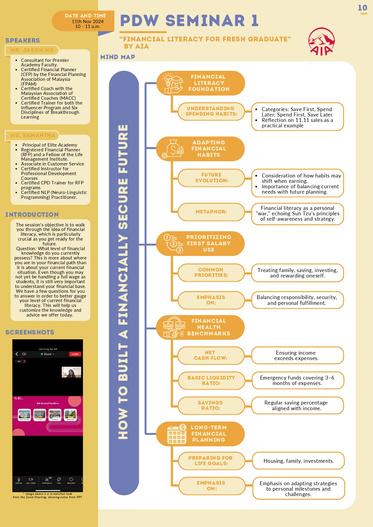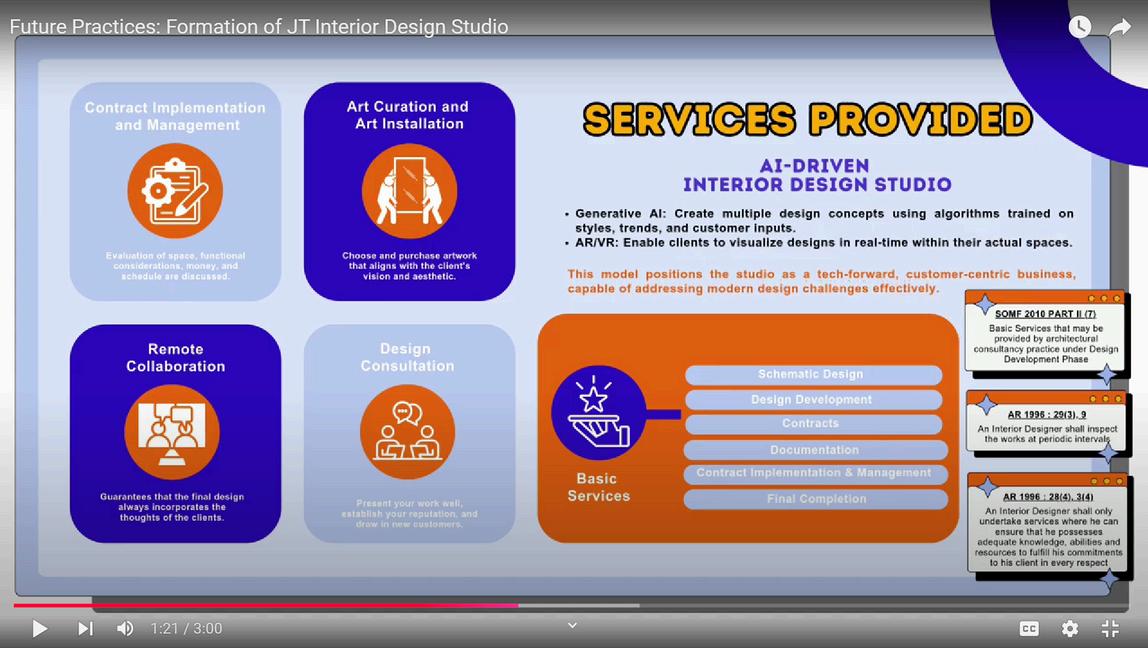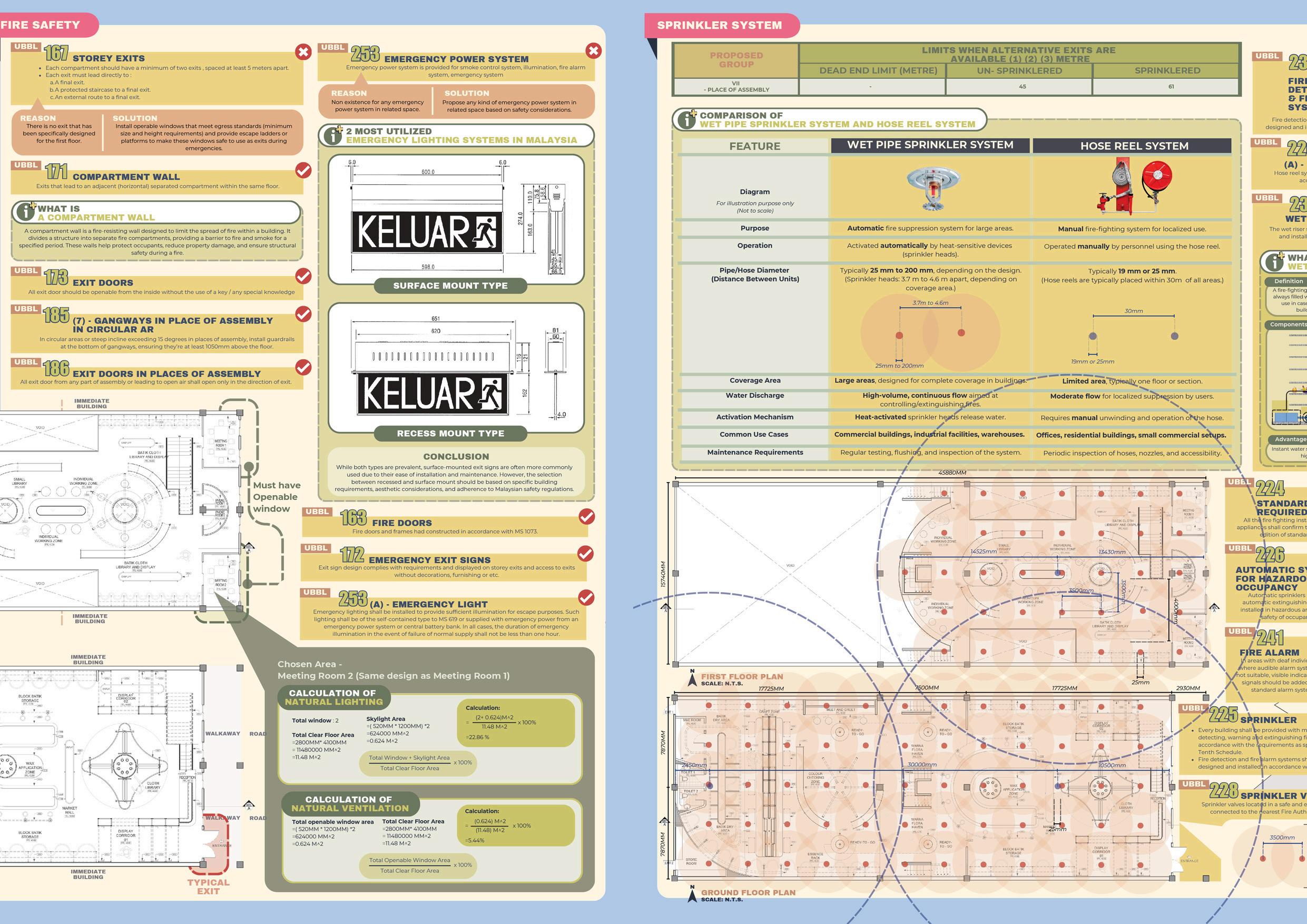E - PORTFOLIO
PROFESSIONAL PRACTICE
Name: Lim Kai Ting
Studednt ID No.: 0349273
Lecturer: Ar. Yasmin Rahman
Assignment
01 03 02 04
001 1 003 3 002 2 004 4
LEGISLATIVE AND REGULATIVE DIMENSION OF INTERIOR DESIGN
Group Presen
Group Video S Exercise (Sho Reflection
KNOWLEDGE EXCHANGE FORUM + PDW
Forum Summa PDW Summary Reflection
FUTURE PRACTICES (FORMATION OF IDCP)
Group Presen
Group Report
Group Video S Reflection
BY-LAW APPLICATION AND PREREQUISITES FOR BUILDING PLAN SUBMISSION
Individual Pre Reflection
TABLE OF CONTENT
REFLECTION
This assignment was a great introduction to understanding the legal and regulatory aspects of interior design. Diving into the Architects Act 1967 and the Uniform Building By-Laws 1984 gave me insight into the frameworks that guide our profession. It emphasized the importance of ethical conduct and compliance in ensuring safe and high-quality designs. Collaborating with my peers to research these laws was challenging but rewarding, as it allowed us to share knowledge and build a stronger understanding together. The creative component, like producing a video presentation, pushed me out of my comfort zone. It taught me how to communicate technical information effectively, which is a skill I know will be useful in my career. Overall, this assignment felt like a crucial step in preparing for real-world practice, providing a solid foundation in understanding the responsibilities and expectations of a professional interior designer.
AND REGULATIVE DIMENSION OF INTERIOR DESIGN 01 01
Assignment
LEGISLATIVE
Students learn Professional Conduct and Practice, exploring legal frameworks like the Architects Act and Uniform Building By-Laws, fostering collaboration, critical analysis, and preparation for future assignments.
Youtube Video Link
https://youtu.be/7OwbqGDHkA4?si=yzA7B9q4JA1Q6GE9
Youtube Video Link
https://youtu.be/7OwbqGDHkA4?si=yzA7B9q4JA1Q6GE9
REFLECTION
This assignment felt more interactive and engaging, as it revolved around collaboration and discussion. Participating in the forums allowed me to explore different perspectives on important topics like fire safety and building regulations. It made me realize how vital it is to address these issues critically while balancing creativity and practicality in design. The Professional Development Week seminars were especially insightful. Listening to industry professionals discuss real-world challenges gave me a broader perspective on the field. Summarizing these sessions helped me process and retain the knowledge, while also refining my ability to communicate ideas concisely. I appreciated how this task combined academic learning with professional growth. It not only built my confidence in discussing industry-relevant topics but also taught me to value collaboration. I now better understand the importance of staying curious and open-minded to evolve as both a designer and a professional.
02
This task promotes democratic exchange in an online forum, allowing every student's voice to be heard, fostering peer communication, and encouraging professional idea-sharing for personal and academic growth.
Forum 03
UBBL Fire Safety ABSTRACT:
The Uniform Building By-Law (UBBL) 1984 mandates passive and active fire safety measures in Malaysian building designs. Interior Designers must understand fire safety to ensure compliance without compromising creativity.
Screenshots of Forum 3
PDW Seminar 1
“Financial Literacy for Fresh Graduate” by AIA
The session's objective is to walk you through the idea of financial literacy, which is particularly crucial as you get ready for the future.
PDW Seminar 2
“Effective Networking through LinkedIn: Tips and Tricks” by Shell
Shell's Graduate Program fostered growth through mentorship, strategic planning, sustainability initiatives, and leveraging LinkedIn for connections and opportunities.
PDW Seminar 3
“Beyond the story : The Secret to Selling Your Ideas” by GRAPH STUDIO
Mr. Derrik emphasizes strategic communication, blending storytelling, emotion, and clarity to transform ideas into exciting projects.
PDW Seminar 4
Support Local Design Dialog by Johnny Chiu x Suzi Sulaiman
Design merges functionality, emotion, and culture, transforming spaces into meaningful experiences and reshaping communities.
REFLECTION
This assignment was both inspiring and practical. It challenged us to think about the future of design and envision our own ideal practice. Reflecting on challenges faced by architects and designers, I learned the importance of addressing these issues creatively while considering the operational realities of running a business. Planning a business model, from structure to branding and financial projections, was eye-opening. It helped me understand how much thought and preparation goes into establishing a design practice that aligns with industry standards. Using insights from previous assignments made the process feel interconnected and purposeful. What stood out to me most was how this task encouraged self-reflection. It pushed me to think about my own vision and values as a designer. This assignment wasn’t just about completing a project it was about preparing for the kind of future I want to create in the industry.
03 03
FUTURE PRACTICES
This assignment encourages students to envision future architectural practices by addressing challenges, proposing solutions, and developing business models while reflecting on Project 1 to define their design firm's vision.
https://www.youtube.com/watch?v=mVAs1WnEWFs
https://www.youtube.com/watch?v=mVAs1WnEWFs
REFLECTION
This assignment underscores the critical integration of design principles with regulatory compliance in professional practice. It challenges students to bridge theoretical knowledge with practical application, ensuring their architectural designs align with by-laws and technical standards. The focus on systematic identification of non-compliance, coupled with proactive rectification strategies, mirrors real-world scenarios. Tasks such as fire safety measures, accessibility, and green building considerations not only emphasize functionality but also ethical responsibility in design. While the structured framework aids clarity, the requirement to adhere to strict guidelines while maintaining creativity highlights the balance architects must achieve between regulation and innovative expression.
04 04
Assignment
Reflection Individual Presentation Spread
FINAL PROJECT: BY-LAW APPLICATION AND PREREQUISITES FOR BUILDING PLAN SUBMISSION
This assignment requires students to apply Project 1 knowledge to AIAD2 projects, illustrating regulations in a detailed report while identifying non-compliance and proposing rectifications without altering designs.


































































